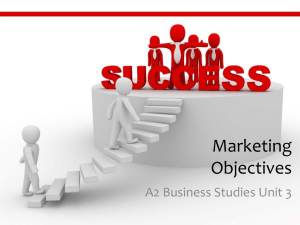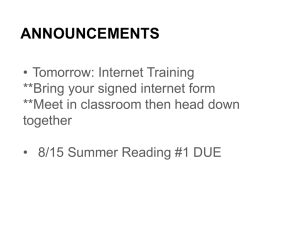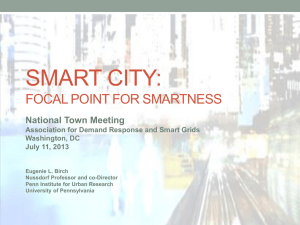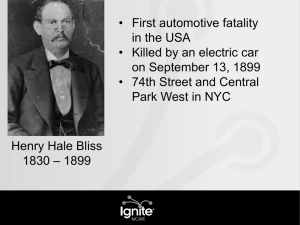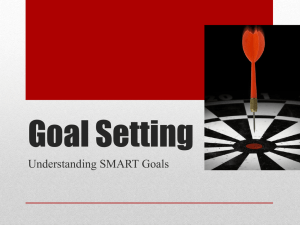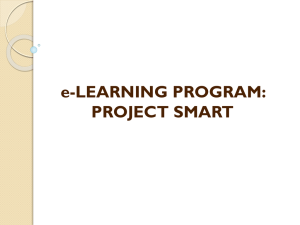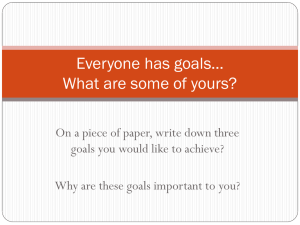Student Learning Goal - Salem
advertisement
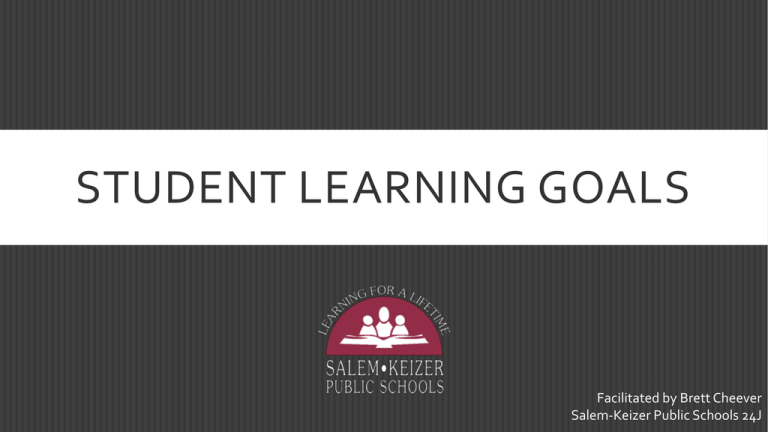
STUDENT LEARNING GOALS Facilitated by Brett Cheever Salem-Keizer Public Schools 24J WHAT’S THE BIG IDEA? Senate Bill 290 has specific goal-setting requirements for all licensed and administrative staff in the State of Oregon. TODAY’S AGENDA: PROFESSIONAL AND STUDENT LEARNING GOALS Background SMART Goals Student Learning Goals Who, What, When? OVERVIEW: THE ROADMAP TO OUR WORK TODAY “Educator evaluation systems are intended to promote professional growth based on standards of professional practice and meaningful measures of teacher and administrator effectiveness.” Oregon Framework for Teacher and Administrator Evaluation and Support Systems Oregon Department of Education OVERVIEW: THE ROADMAP TO OUR WORK TODAY Senate Bill 290 ESEA Waiver Oregon Framework OVERVIEW: THE OREGON FRAMEWORK (1) Standards of Professional Practice (2) Differentiated Performance Levels (3) Multiple Measures (4) Evaluation And Professional Growth Cycle (5) Aligned Professional Development From the Oregon Framework for Teacher and Administrator Evaluation and Support Systems Oregon Department of Education http://www.ode.state.or.us/search/page/?id=3637 OVERVIEW: THE OREGON FRAMEWORK – GOAL SETTING (1) Standards of Professional Practice (2) Differentiated Performance Levels (3) Multiple Measures (4) Evaluation And Professional Growth Cycle (5) Aligned Professional Development From the Oregon Framework for Teacher and Administrator Evaluation and Support Systems Oregon Department of Education http://www.ode.state.or.us/search/page/?id=3637 4 EVALUATION AND PROFESSIONAL GROWTH CYCLE: GOAL SETTING 1 Professional Growth Goal 2 0 1 3 1 4 • SMART Format • Informed by prior observations, evaluations, and self-assessment • Outlines a plan for professional growth and development • We currently do these! 2 Student Learning Goals • SMART Format • Data-driven, using Measures of Student Learning and Growth • Specific requirements on sources of data • The name is new, but … OVERVIEW: STUDENT LEARNING GOALS Student Learning Goals (SLGs) seem new and confusing, but are really just the SMART goals we’re already using! OVERVIEW: STUDENT LEARNING GOALS 2 0 1 3 1 4 Key Point: Student Learning Goals are non-evaluative for 2013-14 LET’S GET SMART: WRITING SMART GOALS “A SMART goal clarifies exactly what is expected and the measures used to determine if the goal is achieved and successfully completed.” “SMART Goals Template” - Stanford University LET’S GET SMART: WHAT IS A SMART GOAL? LET’S GET SMART: IS THIS A SMART GOAL? (GROUP DISCUSSION) I have been invited to speak as an expert at a conference on SMART goals. The conference requires all experts to have published at least one book on their topic of expertise. In order to establish myself as an expert on SMART goals, I will write a 150-page book on how to create SMART goals. I will do this by writing one chapter per month (3-5 pages per week). The book will be completed in 10 months, and will then be selfpublished via Amazon.com. LET’S GET SMART: IS THIS A SMART GOAL? (GROUP DISCUSSION) In order to establish myself as an expert on SMART goals, I will write a 150-page book on how to create SMART goals. I will do this by writing one chapter per month (3-5 pages per week). The book will be completed in 10 months, and will then be self-published. IS IT SPECIFIC? YES. In order to establish myself as an expert on SMART goals, I will write a 150-page book on how to create SMART goals. The book will be completed within 10 months… LET’S GET SMART: IS THIS A SMART GOAL? (GROUP DISCUSSION) In order to establish myself as an expert on SMART goals, I will write a 150-page book on how to create SMART goals. I will do this by writing one chapter per month (3-5 pages per week). The book will be completed in 10 months, and will then be self-published. IS IT MEASURABLE? YES. I will write a 150-page book… I will do this by writing one chapter per month (3-5 pages per week)… LET’S GET SMART: IS THIS A SMART GOAL? (GROUP DISCUSSION) In order to establish myself as an expert on SMART goals, I will write a 150-page book on how to create SMART goals. I will do this by writing one chapter per month (3-5 pages per week). The book will be completed in 10 months, and will then be self-published. IS IT ATTAINABLE? YES. I will do this by writing one chapter per month (3-5 pages per week)… …will then be self-published. LET’S GET SMART: IS THIS A SMART GOAL? (GROUP DISCUSSION) In order to establish myself as an expert on SMART goals, I will write a 150-page book on how to create SMART goals. I will do this by writing one chapter per month (3-5 pages per week). The book will be completed in 10 months, and will then be self-published. IS IT RELEVANT? YES. In order to establish myself as an expert on SMART goals, I will write a 150-page book… LET’S GET SMART: IS THIS A SMART GOAL? (GROUP DISCUSSION) In order to establish myself as an expert on SMART goals, I will write a 150-page book on how to create SMART goals. I will do this by writing one chapter per month (3-5 pages per week). The book will be completed in 10 months, and will then be self-published. T – TIME-BOUND YES. I will do this by writing one chapter per month… The book will be completed in 10 months… STUDENT LEARNING GOALS “Education is not preparation for life; education is life itself.” John Dewey STUDENT LEARNING GOALS: KEY TOPICS What is a Student Learning Goal (SLG)? Who completes SLGs? What is growth? What guidelines should I keep in mind? Student Learning Goal Example(s) Student Learning Goals: What is a Student Learning Goal? STUDENT LEARNING GOALS: WHAT IS A STUDENT LEARNING GOAL? Professional Growth Goal Student Learning Goal SMART Goal SMART Goal Selected by reviewing your prior observations, evaluations, and selfassessment – YOUR “baseline data” Selected by reviewing your students’ prior achievement and results – THEIR “baseline data” Focus on enhancing your professional practice Addresses the most important learning in a course/class Certain requirements set by the State of Oregon STUDENT LEARNING GOALS: ODE DEFINITION OF SLG A specific, rigorous, long-term growth goal for groups of students that represents the most important learning during an interval of instruction. STUDENT LEARNING GOALS: ODE DEFINITION OF SLG – BREAKING IT DOWN A specific, rigorous, long-term growth goal for groups of students that represents the most important learning during an interval of instruction. “long-term” and “interval of instruction”: spanning a year, course, semester, quarter, or other major segment of time. STUDENT LEARNING GOALS: ODE DEFINITION OF SLG – BREAKING IT DOWN A specific, rigorous, long-term growth goal for groups of students that represents the most important learning during an interval of instruction. “most important learning”: addressing the most central standards, skills, concepts, or ideas covered in the class/course. STUDENT LEARNING GOALS: WHAT GUIDELINES APPLY? Your SLGs Must: Be written as a SMART goal Address the most important learning in an interval of instruction Focus on growth, not achievement Between two goals, address all students in class/course Between two goals, use data from 2 of 3 ODE-identified categories STUDENT LEARNING GOALS: A REMINDER… 2 0 1 3 1 4 Key Point: Student Learning Goals are non-evaluative for 2013-14 Student Learning Goals: Who Completes SLGs? STUDENT LEARNING GOALS: WHO COMPLETES THESE GOALS? From ODE: Teacher: Any individual holding a Teacher Standards and Practices Commission (TSPC) teaching license or registration (ORS 342.125 & 342.144) or who is otherwise authorized to teach in the public schools of this state and who is employed as an instructor at .5 FTE and at least 135 consecutive days of the school year (as per ORS 342.840). STUDENT LEARNING GOALS: WHO COMPLETES THESE GOALS? From ODE: Administrator: Any individual holding a TSPC Administrator license includes any licensed educator (ORS 342.125 & 342.144), the majority of whose employed time is devoted to service as a supervisor, principal, vice principal or director of a department or the equivalent in a fair dismissal district but shall not include the superintendent, deputy superintendent or assistant superintendent of any such district or any substitute or temporary teacher employed by such a district. STUDENT LEARNING GOALS: WHO DOES NOT COMPLETE THESE GOALS? School Psychologists Program Assistants Social Workers Instructional Coaches Occupational Therapists Physical Therapists English Language Acquisition Specialists Orientation/Mobility Specialists Behavior Specialists TOSAs Mentor Teachers Student Learning Goals: What is Growth? STUDENT LEARNING GOALS: WHAT IS GROWTH? Growth is… “…a change in student achievement for an individual student between two or more points in time.” US Department of Education (2009) STUDENT LEARNING GOALS: IS THIS GROWTH? My students will be rated as “Meets” on their OAKS Reading results. STUDENT LEARNING GOALS: IS THIS GROWTH? 75% of my students will be rated as “Meets” or higher on their OAKS Mathematics results. STUDENT LEARNING GOALS: IS THIS GROWTH? Each of my students will increase their OAKS RIT score result by 20% from their prior testing results. STUDENT LEARNING GOALS: IS THIS GROWTH? Each of my students will improve their rating received on their pre-assessment by one level of proficiency when completing their annual summative assessment. STUDENT LEARNING GOALS: WHAT GUIDELINES APPLY? Your SLGs Must: Be written as a SMART goal Address the most important learning in an interval of instruction Focus on growth, not achievement Between two goals, address all students in class/course Between two goals, use data from 2 of 3 ODE-identified categories Student Learning Goals: What Students Need to be Included? STUDENT LEARNING GOALS: GUIDELINES – WHAT STUDENTS TO INCLUDE? Must write 2 Student Growth Goals in SMART format Between the two goals, we are required to address all students in a particular class or course. STUDENT LEARNING GOALS: WHAT IS A CLASS/COURSE AT ELEMENTARY? Grade Level: 3rd Grade, 4th Grade, etc… PE / Music: By Grade Level, By Content (Orchestra) Specialists: By Grade, By All Pullout Counseling/Guidance: By School, By Grade STUDENT LEARNING GOALS: WHAT IS A CLASS/COURSE AT SECONDARY? By Course: 6th Grade Block, Algebra I, Economics Must select all periods of a given course – If I teach 3 periods of Algebra I and select it as a focus, I must address my students in all 3 periods. PE / Music: By Grade Level, By Content (Orchestra) Specialists: By Grade, By Pullout Counseling/Guidance: By School, By Grade STUDENT LEARNING GOALS: GUIDELINES – WHAT STUDENTS TO INCLUDE? For example: If I was 4th grade teacher, I could write 1 goal around OAKS Reading (which includes 100% of my students). My 2nd goal could focus on either all of my students, or could target a specific sub-population of students I would like to work with. STUDENT LEARNING GOALS: GUIDELINES – WHAT STUDENTS TO INCLUDE? For example: If I was a Social Studies teacher, I could select my three periods of “World History” as my course. My 1st goal could focus upon my TAG-identified students in my course, and my 2nd goal could focus on my nonTAG identified students. STUDENT LEARNING GOALS: WHAT GUIDELINES APPLY? Your SLGs Must: Be written as a SMART goal Address the most important learning in an interval of instruction Focus on growth, not achievement Between two goals, address all students in class/course Between two goals, use data from 2 of 3 ODE-identified categories Student Learning Goals: What Data Sources Should be Used? STUDENT LEARNING GOALS: GUIDELINES - DATA CATEGORIES Three Categories of Assessment Data Category One Category Two Category Three State or National Standardized Assessments Common National, International, Regional, or District-Developed Measures Classroom-based or School-wide Measures ACT, PLAN, EXPLORE, AP, IB, DIBELS, Easy CBM OAKS, Smarter Balanced (when adopted), ELPA Other common assessments approved by state/district as valid, reliable and able to be scored comparably across schools or classrooms Student performances, portfolios, products, projects, work samples, tests STUDENT LEARNING GOALS: GUIDELINES - DATA CATEGORIES Are you in an OAKS Reading or Math tested grade or subject? (ODE defined as ELA and mathematics in grades 3-8 and 11) YES • 1 Goal MUST use OAKS or ELPA • 1 Goal will use a data source from Category 2 or 3 NO • 2 Goals using data sources from Categories 1, 2, or 3 • May only use a category once; two categories total must be selected STUDENT LEARNING GOALS: WHAT GUIDELINES APPLY? Your SLGs Must: Be written as a SMART goal Address the most important learning in an interval of instruction Focus on growth, not achievement Between two goals, address all students in class/course Between two goals, use data from 2 of 3 ODE-identified categories Student Learning Goals: The Form Itself STUDENT LEARNING GOALS: THE SLG FORM Located in TalentED Perform 2 Goal Forms Form Questions Context Baseline Data Goal Statement Strategies Related Professional Development Data Source(s) Demographics (e.g., total # of students) Learning Needs (e.g., # ELL, % TAG vs non-TAG, # IEPs) Other Relevant Class/Course Characteristics (e.g., Credit Recovery, Advanced Placement) Student data used as baseline to set goal (e.g., pre-assessment results, prior year’s OAKS, work sample scoring) Could include additional, non-baseline data used to show performance trends for students Written as a SMART goal Growth, not achievement Meets ODE guidelines (for students included, data sources) Answers the question: how will I work to attain this goal? Can be adjusted throughout year. Learning (training, books, classes, workshops) that you feel would assist you in supporting this goal Optional Year-End Goal Conference Mid-Year Review STUDENT LEARNING GOALS: THE FORM ITSELF – MID-YEAR AND END OF YEAR Goal Progress Review Strategy Modification (if any) End-of-Year Data Reflection on Results Implications for Next Year’s Goals Student Learning Goals: Due Date and Practice STUDENT LEARNING GOALS: WHEN ARE THEY DUE? Student Learning Goals and Professional Growth Goals must be submitted via TalentED Perform by November 27, 2013. STUDENT LEARNING GOALS: IS THIS A SMART STUDENT GROWTH GOAL? During the 2013-14 school year, each of my sixth-grade physical education students will improve on the Presidential Fitness subtests (curl-ups, shuttle run, endurance run/walk, pullups, V-sit reach) by an overall average of 20%. STUDENT LEARNING GOALS: IS THIS A SMART STUDENT GROWTH GOAL? All students will demonstrate measurable progress in each of the art scoring rubric areas (Elements & Principles, Creativity & Originality, Craftsmanship/Skills). At least 50% of students will score 3 on the 5-point rubric. STUDENT LEARNING GOALS: IS THIS A SMART STUDENT GROWTH GOAL? In my year-long, 2013-14 Art I elective, all students will demonstrate measurable progress in each of the art scoring rubric areas (Elements & Principles, Creativity & Originality, Craftsmanship/Skills). At least 50% of students will score 3 on the 5-point rubric. STUDENT LEARNING GOALS: TABLE ACTIVITY Using the data lists your table created, select a data source and write a potential SMART Student Growth Goal Statement. STUDENT LEARNING GOALS: QUESTIONS? THANK YOU! Brett Cheever Staff Quality Coordinator Email: cheever_brett@salkeiz.k12.or.us Salem-Keizer Public Schools Human Resources Department Ph. 503-399-3061
